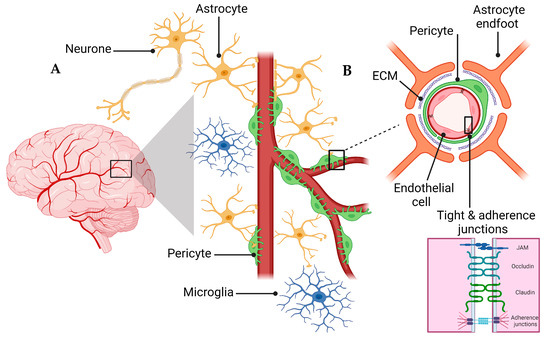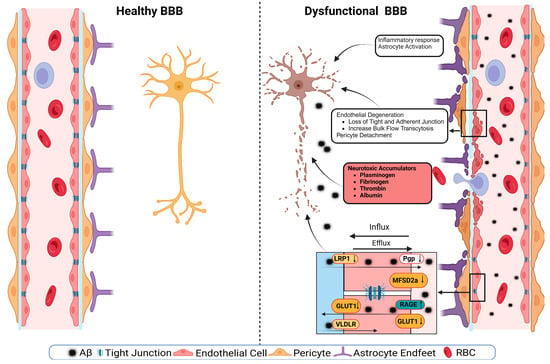A schematic presentation of the discussed mechanisms is presented in
Figure 2. The disruption of the BBB could impair any of the NVU cellular components. The disruption of endothelial cells might result in a decreased TJs’ expression. It has been shown that occludin, claudin-5, and ZO1 expressions are lower in the Aβ-laden capillaries of patients with capillary CAA
[31], implying that reduced TJs may increase the vascular permeability in an AD brain. Multiple cellular signaling pathways, such as calcium signaling, could mediate the disruption of TJs. In AD, the RAGE–Aβ
42 interaction disrupts TJs via a calcium-calcineurin signaling pathway
[68]. In addition, in the monolayer culture of bEnd3 cells, adding Aβ
42 induces structural alterations in ZO1
[68]. Other TJ proteins, such as claudin-5 and occludin, were also structurally altered, and their expression was reduced by Aβ
42 [68]. This result was confirmed as neutralizing antibodies against RAGEs and calcineurin and MMP inhibitors prevented Aβ
42-induced changes in the ZO1 expression
[68]. Furthermore, the expression of TJs is negatively correlated with Aβ
40 levels in cortical areas and positively correlated with synaptic markers in patients with AD, highlighting the role of TJs in the AD pathology development
[69].
Figure 2. A representative scheme demonstrates a healthy BBB and a dysfunctional BBB.
Transport protein expression alterations in endothelial cells could be a mechanism or a consequence of BBB disruption
[70]. In AD, the failure of Aβ clearance through transport across the BBB is caused by decreased levels of LRP1 and P-gp and an increased RAGE expression. For example, in an in vitro experiment, a high cholesterol level decreased the LRP1 expression, increased the RAGE expression, and increased Aβ40 levels in cerebral microvascular endothelial cells
[71]. Other transport disruptions include a reduced expression of the GLUT1 transporter
[70][72]. This effect was seen with a lower expression of GLUT1 in endothelial cells but not in astrocytes of the BBB in GLUT1-deficient APP
sw-mice
[73]. The LRP1 protein is vital to maintain the BBB’s integrity; it acts as a co-activator of peroxisome proliferator-activated receptor gamma (PPARγ), transports cholesterol associated with ApoE
[74], plays a role in glucose metabolism
[75], and interacts with Aβ to transport it across the BBB
[74]. The LRP1 activation can stimulate PPARγ and increase TJs’ expression. This effect has been investigated in mouse models where a selective brain endothelial LRP1 knockout reduced the expression of TJ proteins and P-gp, increased the MMP activity, and decreased the TEER, leading to endothelial cell disruptions
[76]. Endothelial cell disruption causes neuroinflammation due to neurotoxic substances infiltrating into the brain, causing inflammation and neurodegeneration. Fibrinogen leakiness in the brain activates the macroglia and initiates inflammation
[77][78].
Aside from endothelial cell disruptions, neuroinflammation and the activation of glial cells can further drive AD pathology. Microglial activation can release pro-inflammatory factors, resulting in neuroinflammation
[79]. Although inflammation is a protection mechanism, an overly aggressive inflammatory response can cause or contribute to tissue damage. In AD, astrocyte degeneration causes the BBB disruption. Using tamoxifen-astrocyte-depleted mice, large molecules such as fibrinogen and smaller molecules such as cadaverine, an exogenous labeled small molecule, were detected in the brain as soon as the astrocytes were depleted, which was accompanied by reduced levels of TJ proteins, and lower expression of GLUT1
[80]. Aquaporin-4 (AQP-4), a water channel facilitating bidirectional water transfer, is expressed by astrocytes at the BBB
[81].
The nucleotide-binding oligomerization domain-like receptor pyrin domain-containing 3 (NLRP3) inflammasome has a significant role in AD-related neuroinflammation. The interaction of Aβ with astrocytes and macroglia can activate NLRP3 inflammasome, causing the release of chemokines and inflammatory mediators and activating the caspase-1 cascade
[82]. The activation of NLRP3 inflammasome results in the BBB breakdown by the generated cytokines, whereas reducing the inflammasome activation reduces the inflammatory response and improves the BBB function
[83]. NF-κB is another inflammatory transcription factor that is increased in AD. The activation of NF-κB by Aβ plaques, NFT, or oxidative stress causes the release of proinflammatory cytokines and ROS and promotes neuroinflammation. Like neuroinflammation, oxidative stress plays a significant role in the BBB disruption
[79]. Oxidative stress is a condition produced by an imbalance between the generation and accumulation of ROS in cells and tissues and the ability of a biological system to detoxify these reactive products
[84]. Neuroinflammation and oxidative stress result in neuronal cell death, altered neurotransmitter production and activity, and decreased synaptic functioning, all of which can lead to cerebral injury and dysfunction
[85][86].
In AD, Aβ deposits cause pericyte degeneration
[87][88]. Aβ-pericytes signaling causes vascular constriction and decreases CBF through ROS generation in humans and rodents
[89]. This degeneration is affected by the ApoE isoform where ApoEε4 accelerates the BBB breakdown; ApoEε4 also reduces the calcineurin–nuclear factor of activated T cells (NFAT) signaling in pericytes and causes the BBB disruption
[90]. ApoEε4 iPSC-derived-mural cells expressed higher levels of cytoplasmic and nuclear NFATc1 protein and exhibited a higher gene expression of calcineurin catalytic subunits (PPP3CA and PPP3CC). Increased levels of NFATc1 induce the CAA pathology by interacting with ApoEε4 promoter in ApoEε4-expressing pericytes. Inhibiting calcineurin in iPSC-derived mural cells reduced ApoE expression in ApoE4-expressing cells and NFATc1 in ApoE3-expressing cells
[90].
In AD, the dysfunction of the Wnt/β-catenin signaling pathway has been associated with the BBB breakdown. Under normal conditions, Wnt/β-catenin signaling is essential for the CNS angiogenesis
[91]. Reduction in this signaling pathway reduces the expression of TJs and modulates the expression of transporters such as P-gp and GLUT1, leading to an increased BBB permeability
[91]. Suppressing Wnt/β-catenin signaling in the APP
swe/PS1
dE9 (APP/PS1) microvessels increased glycogen synthase kinase-3 beta (GSK-3β), whereas its activation, using LRP6-optogenetic tool, restored the BBB TJs, and prevented Aβ-induced endothelial cells’ dysfunction
[92]. The same effect has been shown in human iPSCs where the activation of the Wnt/β-catenin pathway using CHIR 99021 (CHIR), an inhibitor of GSK-3β and an agonist of Wnt/β-catenin, induced GLUT1 and claudin-5 expressions, and downregulated levels of plasma lemma vesicle-associated protein (PLVAP)
[93]. Wnt/β-catenin signaling also regulates paracellular and transcellular permeabilities
[94].
The genetic underpinnings of the BBB dysfunction in AD provide a fascinating, yet relatively understudied, angle to the ongoing research in the field. A significant proportion of genes implicated in the AD risk have been linked to the brain’s vascular and perivascular systems, further suggesting the integral role of the BBB’s integrity in the AD pathogenesis. The human brain vasculature expresses 30 out of the top 45 genes linked to the AD risk based on genome-wide association studies (GWAS)
[95]. Remarkably, several genes identified in GWAS, including PICALM, known for its involvement in endocytosis facilitating the internalization of cell receptors, have variants that can increase the Aβ accumulation in the brain, exacerbating the AD pathology
[96], as shown by triggering clathrin-mediated endocytosis through its interaction with LRP1
[97].
Mutations in the OCLN gene, responsible for encoding occludin
[98], and the junctional adhesion molecule-C (JAM-C) gene, responsible for encoding the junctional molecule JAM-C, are directly implicated in the compromise of the BBB’s integrity
[99][100]. Furthermore, NOTCH3 gene, vital for vascular integrity through smooth muscle cell differentiation, presents mutations that affect blood vessel walls and the BBB’s integrity, further linking it to AD and vascular dementia
[101]. Mice with the CADASIL-associated Notch3-R169C mutation exhibit an accumulation of the NOTCH ectodomain within pericytes. This accumulation is concomitant with the pericyte degeneration and a subsequent compromise of the BBB’s integrity
[102].
TREM2, which encodes the triggering receptor expressed on myeloid cells 2 protein, was highlighted as an AD susceptibility gene in two GWAS
[103][104]. Notably, these studies identified the R47H missense mutation, which presents a heightened AD risk comparable to possessing one ApoEε4 allele
[103]. Predominantly expressed in brain microglia, TREM2 is pivotal in mediating the neuroinflammatory reactions associated with AD
[105]. In-depth functional analyses of TREM2 have elucidated its involvement in the modulation of Aβ plaque accumulation in brain parenchyma, the advancement of tau-related pathology, and BBB dysfunction
[104][106][107][108]. TREM2 may affect the integrity of the BBB by affecting inflammation, the microglial oxidative response, and insulin resistance. Moreover, many studies have found that soluble TREM2 (sTREM2) may disrupt the BBB’s integrity in AD by interacting with pro-inflammatory proteins such as TNF receptor 1 and TNF receptor 2, and their effectors like intercellular adhesion molecule 1 and vascular cell adhesion molecule 1
[109].
6. The BBB as a Therapeutic Target
The BBB dysfunction has been implicated in the pathogenesis of AD and many other neurodegenerative diseases
[25][110]. While there are new medications targeting Aβ, such as the recent FDA-approved monoclonal antibody Lecanemab, a curative therapy for AD remains elusive. Furthermore, these medications are associated with severe adverse reactions, including edema and cerebral microhemorrhages
[111]. Such concerns underscore the potential need for combined therapies that simultaneously address the BBB function and other key aspects of AD. Accordingly, there has been a growing interest in developing therapeutic strategies that target the BBB to enhance drug delivery, improve the clearance of toxic molecules, and restore the barrier function
[112]. Strategies to modulate the BBB function in AD can be broadly categorized into three main areas: enhancing the Aβ clearance across the BBB, improving the BBB’s integrity and function, and addressing neuroinflammation
[25][110]. Indeed, the intricate regulation of Aβ transporters, both influx and efflux, plays a crucial role in the Aβ accumulation. The dysregulation of these transporters has been recognized as a potential therapeutic target of AD
[112].


